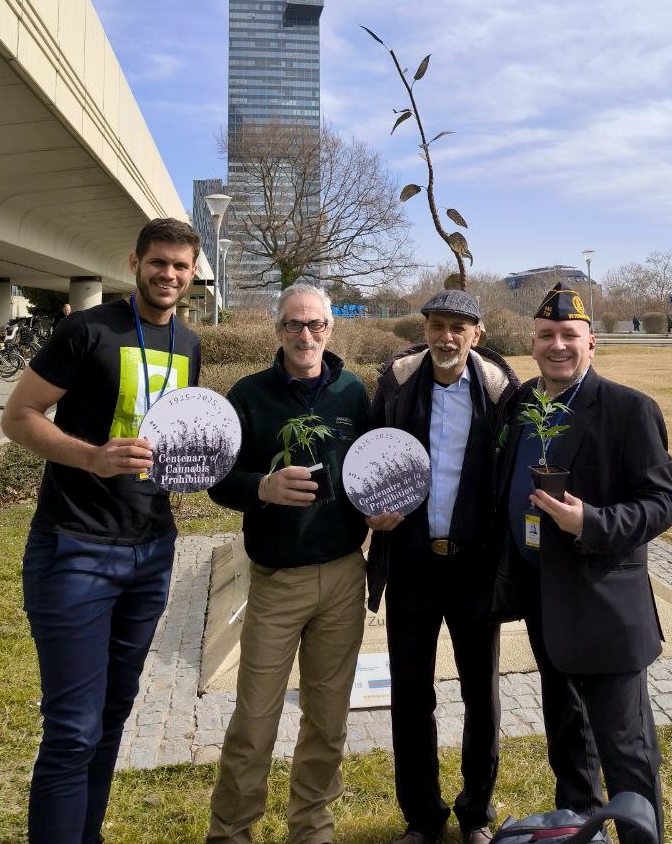The year 2025 marks a somber milestone: the centenary of international cannabis prohibition. What began in Geneva in 1925, when global powers agreed to classify “Indian hemp” as a narcotic under the International Opium Convention, has since shaped a century of misguided policy, criminalization, and cultural stigma.
“This is not a moment for celebration,” says longtime activist and Berkeley Patients Group co-founder Etienne Fontan. “It’s a moment to reflect on the generations harmed, the science suppressed, and the patients denied access to a plant that’s been with humanity since the beginning.”
A Global Chorus of Remembrance & Reform

Across the world, activists, researchers, and organized communities of farmers and advocates have turned the centenary into an opportunity—not just to mourn what has been lost, but to demand a future rooted in justice, science, access, and human rights reparations.
- At the United Nations Commission on Narcotic Drugs (CND68) last in March in Vienna, the Cannabis Embassy set up the first ever Cannabis info table & exhibition inside the lobby where world leaders – the majority of whom remain prohibitionist – meet.
And ENCOD led a historic side event titled “1925–2025: One Centenary of Cannabis as a Narcotic Drug Under International Control”, driving home the point: “For 99% of human history, cannabis was neither prohibited nor problematic.” - Fields of Green for ALL hosted a side event at CND titled “Cannabis in Africa”, focusing on the continued human rights abuses across a largely prohibitionist continent. Back home in South Africa, they got their Government to acknowledge the Centenary of Cannabis Prohibition and launched media events nationwide.
- In Paris, Cannabis without Borders and its partners NORML France used their annual Marijuana March to spotlight the 100-year mark, calling prohibition “a century of failure that must end.”
- In Nepal, activists used the opportunity of the Centenary to launch a campaign to protect the country’s landraces, lobbying the government to adopt the recent “GRATK” Treaty against biopiracy and the illegitimate patents on landraces and traditional cannabis knowledge.
- Toronto hosted “Reclaiming Our Narratives,” a four-day exhibit tracing the history of cannabis in Black communities from pre-colonial times to the modern legalization movement.
- In Chile, the Foundation “Todo lo que Cultivas, Eleva” kick-started the official process, which will recognize Cannabis Cultures as a protected Intangible Cultural Heritage. At the same time, Cannabis Embassy curated events and statements for the 2025 Barcelona UNESCO Conference to advocate for the cultural recognition of the plant’s historic role and the protection of diverse cannabis communities worldwide.
“The beauty of this moment,” Fontan says, “is that after 100 years of prohibition, we’re finally reclaiming our story. From patients to veterans to farmers, this movement has always been about people first.”
A Century of Lost Potential
A recent Nature feature distilled the damage: “A century of prohibition has severely restricted development of breeding and germplasm resources, leaving potential hemp-based nutritional and fibre applications unrealized.”
Fontan, who has spent three decades lobbying for cannabis access, sees this loss every day: “If we’d had even half the research freedom that exists now, we could’ve saved countless lives—especially veterans dealing with pain, trauma, and other conditions that cannabis treats so effectively. The cost of prohibition isn’t just economic; it’s human.”
Why It All Began
Ironically, it wasn’t the United States that first pushed prohibition onto the global stage. In 1925, Egypt, South Africa, and Mussolini’s Italy were among the key voices lobbying against cannabis at the international level. The 1925 convention’s aim was narrow, restricting trafficking, but the stigma it codified rippled outward for generations.
What We’ve Lost… and What We Can Reclaim
Humanity’s relationship with Cannabis stretches back thousands of years. From Emperor Shen-Nung’s medicinal texts in 2737 BCE to Egyptian papyri recommending cannabis for pain relief, to Persian, Arabic, and Greco-Roman medicine utilizing it for anesthesia, inflammation, and wound care, the plant was once a valued partner in health and culture.
Fontan reflects, “If the history of cannabis and humankind were a clock, prohibition would only be its last two minutes. We’ve got thousands of years of partnership to look back on, and that’s what keeps me hopeful about where we’re headed.”
From Reform to Abolition
Legalization movements have made significant strides; Germany, Thailand, Canada, and dozens of U.S. states are revising their laws, but many advocates argue that reform isn’t enough.
“100 Years of Cannabis Prohibition: Time for abolition, not just legalization,” wrote activist Beenie Words, capturing the call to move beyond incremental policy shifts to dismantle prohibition’s legacy fully.
Fontan agrees: “Legalization is a start, but abolition is the goal. Until the last person is out of prison for a plant, and every patient can access safe medicine without stigma or fear, our work isn’t done.”
A New Chapter
One hundred years in, the tide is turning. Scientific breakthroughs, grassroots activism, and shifting public opinion are converging to push the plant back into the light. “This centenary isn’t just about looking back,” Fontan says. “It’s about making sure the next hundred years are defined by respect, freedom, equity, and the truth about this plant. We’ve come too far—and lost too much—to settle for anything less.”
This article is from an external, unpaid contributor. It does not represent High Times’ reporting and has not been edited for content or accuracy.


























